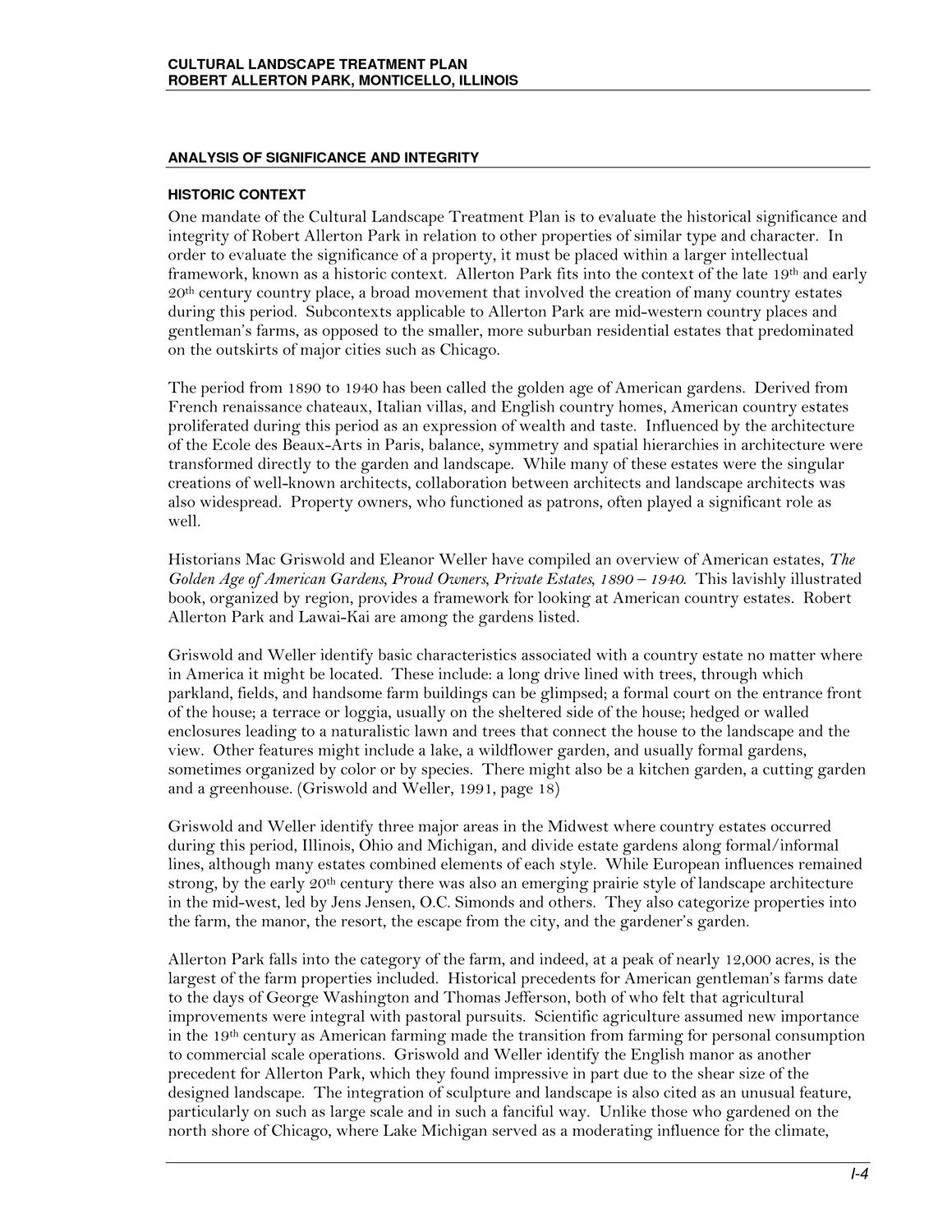| |
| |
Caption: Map of UIUC (2001) (Allerton)
This is a reduced-resolution page image for fast online browsing.

EXTRACTED TEXT FROM PAGE:
CULTURAL LANDSCAPE TREATMENT PLAN ROBERT ALLERTON PARK, MONTICELLO, ILLINOIS ANALYSIS OF SIGNIFICANCE AND INTEGRITY HISTORIC CONTEXT One mandate of the Cultural Landscape Treatment Plan is to evaluate the historical significance and integrity of Robert Allerton Park in relation to other properties of similar type and character. In order to evaluate the significance of a property, it must be placed within a larger intellectual framework, known as a historic context. Allerton Park fits into the context of the late 19th and early 20th century country place, a broad movement that involved the creation of many country estates during this period. Subcontexts applicable to Allerton Park are mid-western country places and gentleman’s farms, as opposed to the smaller, more suburban residential estates that predominated on the outskirts of major cities such as Chicago. The period from 1890 to 1940 has been called the golden age of American gardens. Derived from French renaissance chateaux, Italian villas, and English country homes, American country estates proliferated during this period as an expression of wealth and taste. Influenced by the architecture of the Ecole des Beaux-Arts in Paris, balance, symmetry and spatial hierarchies in architecture were transformed directly to the garden and landscape. While many of these estates were the singular creations of well-known architects, collaboration between architects and landscape architects was also widespread. Property owners, who functioned as patrons, often played a significant role as well. Historians Mac Griswold and Eleanor Weller have compiled an overview of American estates, The Golden Age of American Gardens, Proud Owners, Private Estates, 1890 – 1940. This lavishly illustrated book, organized by region, provides a framework for looking at American country estates. Robert Allerton Park and Lawai-Kai are among the gardens listed. Griswold and Weller identify basic characteristics associated with a country estate no matter where in America it might be located. These include: a long drive lined with trees, through which parkland, fields, and handsome farm buildings can be glimpsed; a formal court on the entrance front of the house; a terrace or loggia, usually on the sheltered side of the house; hedged or walled enclosures leading to a naturalistic lawn and trees that connect the house to the landscape and the view. Other features might include a lake, a wildflower garden, and usually formal gardens, sometimes organized by color or by species. There might also be a kitchen garden, a cutting garden and a greenhouse. (Griswold and Weller, 1991, page 18) Griswold and Weller identify three major areas in the Midwest where country estates occurred during this period, Illinois, Ohio and Michigan, and divide estate gardens along formal/informal lines, although many estates combined elements of each style. While European influences remained strong, by the early 20th century there was also an emerging prairie style of landscape architecture in the mid-west, led by Jens Jensen, O.C. Simonds and others. They also categorize properties into the farm, the manor, the resort, the escape from the city, and the gardener’s garden. Allerton Park falls into the category of the farm, and indeed, at a peak of nearly 12,000 acres, is the largest of the farm properties included. Historical precedents for American gentleman’s farms date to the days of George Washington and Thomas Jefferson, both of who felt that agricultural improvements were integral with pastoral pursuits. Scientific agriculture assumed new importance in the 19th century as American farming made the transition from farming for personal consumption to commercial scale operations. Griswold and Weller identify the English manor as another precedent for Allerton Park, which they found impressive in part due to the shear size of the designed landscape. The integration of sculpture and landscape is also cited as an unusual feature, particularly on such as large scale and in such a fanciful way. Unlike those who gardened on the north shore of Chicago, where Lake Michigan served as a moderating influence for the climate, I-4
| |